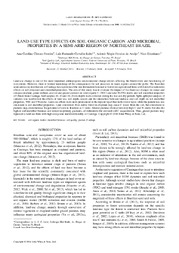Land-use type effects on soil organic carbon and microbial properties in a semi-arid region of Northeast Brazil.
Land-use type effects on soil organic carbon and microbial properties in a semi-arid region of Northeast Brazil.
Author(s): FERREIRA, A. C. C.; LEITE, L. F. C.; ARAÚJO, A. S. F. de; EISENHAUER, N.
Summary: ABSTRACT - Land-use change is one of the most important anthropogenic environmental change drivers affecting the biodiversity and functioning of ecosystems. However, there is limited knowledge of the consequences for soil processes in many regions around the globe. The Brazilian semi-arid ecosystem known as Caatinga has experienced the transformation from native forest into agricultural land, with heretofore unknown effects on soil processes and microbial properties. The aim of this study was to evaluate the impact of ?ve land-use changes (to maize and cowpea cropland, grape orchard, and cut and grazed pasture) on total organic C (TOC) and total N (TN) stocks and soil microbial properties of Ultisol from Caatinga. Soil samples (0–10 and 10–20 cm depth) were collected during the wet and dry periods. Split–split plot analysis of variance was used to test the effects of land use, soil depth, season and the interaction between land-use and soil depth on soil microbial properties, TOC and TN stocks. Land-use effects were more pronounced in the top soil layer than in the lower layer, while the pattern was less consistent in soil microbial properties. Land conversion from native forest to cropland may cause C losses from the soil, but conversion to pastures may even increase the potential of soils to function as C sinks. Grazed pastures showed not only high C and N stocks but also the highest soil microbial biomass and lowest respiratory quotients, all indications for elevated soil C sequestration. Thus, grazed pastures may represent a land-use form with high ecosystem multifunctionality in Caatinga.
Publication year: 2016
Types of publication: Journal article
Unit: Embrapa Mid-North
Observation
Some of Embrapa's publications are published as ePub files. To read them, use or download one of the following free software options to your computer or mobile device. Android: Google Play Books; IOS: iBooks; Windows and Linux: Calibre.
Access other publications
Access the Agricultural Research Database (BDPA) to consult Embrapa's full library collection and records.
Visit Embrapa Bookstore to purchase books and other publications sold by Embrapa.

